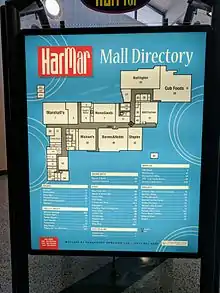 A row of shops in Har Mar Mall's western façade | |
| Location | Roseville, Minnesota, United States |
|---|---|
| Coordinates | 45°00′17″N 93°09′50″W / 45.0046°N 93.1638°W |
| Address | 2100 North Snelling Avenue |
| Opening date | August 1963 |
| Management | Vanbarton Services LLC |
| Owner | Vanbarton Group LLC |
| Architect | Thorsen Associates[1] |
| No. of stores and services | 45 |
| No. of anchor tenants | 17 |
| Total retail floor area | 430,000 square feet (40,000 m2) |
| No. of floors | 1 |
| Public transit access | |
| Website | harmarmall |
Har Mar Mall is an enclosed shopping mall in Roseville, Minnesota, United States, a suburb of the Twin Cities. Har Mar Mall comprises over 430,000 square feet (40,000 m2) of retail space and the mall's anchor stores are Famous Footwear, Michaels, HomeGoods, Barnes & Noble, Staples, K&G Fashion Superstore, Burlington, Cub Foods, H&R Block, Tuesday Morning , Marshalls, David's Bridal , Painting with a Twist, Sport Clips, Waxing the City, Elements Massage, and a Chase Bank branch. The mall contains 45 tenants.
Opened in 1963 and expanded several times since, it is one of two enclosed malls in Roseville; the other is Rosedale Center. Despite being a relatively small shopping center, Har Mar Mall remains open. It was constructed by Robert W. Fendler of Fendler Patterson and is owned and managed by the Vanbarton Group and Varbarton Services respectively.
History
Construction for the Har Mar Mall began in 1961, when Harold J. Slawik had a vision to build a "super mall", similar to shopping centers he had seen while traveling in Florida.[2] Deriving its name from its owners – Harold J. Slawik and his wife Marie – Har Mar is a combination of the two names. It was built upon 50 acres of land near a busy intersection in Roseville, Minnesota.[2] Minnesota native Willard Thorsen, who designed Apache Plaza in nearby St. Anthony, designed the mall,[3] while Robert W. Fendler served as the mall's architect.[4] According to Thorsen, the mall consists of "a long corridor, which zigzags at a series of angles... that make Har Mar truly unique";[5] it features "massively wide" hallways and "arched ceilings with large windows" to allow natural light to enter the corridors.
The mall cost nearly $6 million to construct over a span of two years.[6] During the summer of 1962, Harold Slawik died, leaving his wife in charge of the mall's construction; Mrs. Slawik reportedly worked 80 hour weeks in order to keep up with the mall.[6] In May of the same year, Target constructed their first location in a parking lot directly north of Har Mar.[7] While nearby Rosedale Center was constructed in 1969, Har Mar went through a significant expansion in the early 1970s.
In 1970, the construction of a twin theater, Har Mar 1 & 2, was completed and became the Twin Cities' second double-screened cinema; its luxurious design included a "spacious lobby, with three Venetian glass chandeliers and bubbling fountains". It was originally owned by General Cinema Corporation (GCC, later acquired by AMC Theatres) and constructed by architect Benjamin Gingold Jr.[8] In 1977, the larger of the theater’s two auditoriums was itself twinned, creating a triplex, as the theater was renamed the Har-Mar 3. In 1981, a former grocery store behind the theater was transformed into another eight small screens, giving the theater 11 screens total, making it the largest (and at times the top-grossing) cinema theater in the state.[9]
On June 14, 1981, Har Mar Mall was damaged by a large tornado during the afternoon hours.[10] While the mall wasn't heavily damaged and only affected the mall's cosmetic appearance, several nearby local businesses and residences were left in ruins following the impact.[10] Shortly after the tornado, a large renovation occurred to update the mall's appearance and fix any damage left by it.[5] In 1988, another expansion took place, allowing Har Mar to acquire several larger retailers in the newly constructed space; the opening of Highland Superstore and TJ Maxx appeared later this year, along with the addition of a new food court with seating for over 400 people.[11] Three years later, the Highland Superstore was converted to BizMart, a regional office supply store.[12] BizMart was later acquired by OfficeMax in 1992 before ultimately closing in 1995; HomePlace opened in the space vacated by OfficeMax, and is currently leased by HomeGoods, the successor of HomePlace.[13] In the 2000s, Har Mar underwent a cosmetic makeover that cost previous owner Emmes Realty Services nearly $12 million; Emmes sparked interest in opening a Von Maur at the center, but the proposal eventually dissolved.[14]

By the early 2000s, the once-booming cinema had become outdated in technology and in seating styles. In 2006, AMC (which owned the Har Mar theaters) opened a new theater complex nearby in Rosedale with digital technology and stadium seating, and the once-thriving screens at Har Mar were permanently shuttered.[9][15]
In 2014, Burlington Coat Factory, a discount apparel retailer, announced that they planned to lease a 52,300 square feet (4,900 m2) space previously occupied by Northwestern Books; the opening of this location allowed all of Har Mar's anchor tenants to be completely leased.[16] Currently, the mall still prospers mixing "large, special interest stores, as well as a variety of smaller, more unique stores" under one roof.[17] Several new tenants and businesses have begun leasing space in the center, such as Staples Inc., D'Amico & Sons, plus several other fine dining establishments.[18]
In popular culture
Har Mar Superstar, an indie rock musician and leader of the musical group Sean Na Na, took his stage name from Har Mar Mall. According to Sean Tillmann, Superstar's legal name, he acquired the name after spending his youth "watching movies and writing songs about passers-by in the food court".[19] He visited the shopping mall frequently as "it was across the street from where [he] worked in an office job".[20]
References
- ↑ Minnesota Modern Registry, Docomomo US MN, accessed May 18, 2022.
- 1 2 "About Us". Roseville Midway Ford. Retrieved April 12, 2016.
- ↑ "Willard Thorsen collection". Northwest Architectural Archives, Manuscripts Division. Retrieved April 12, 2016.
- ↑ Longworth, Nick (November 20, 2015). "Fendler Patterson celebrates 50 years". Savage Pacer. Retrieved June 3, 2016.
- 1 2 "HarMar Mall: Space for Real Life". E-Democracy. Retrieved April 12, 2016.
- 1 2 Woltman, Nick (April 8, 2015). "Har Mar Mall founder Marie Slawik honored posthumously". Pioneer Press. Retrieved April 12, 2016.
- ↑ von Hoffman, Alexander. "Profiles in Preservation: Sienna Green Apartments in Roseville, Minnesota" (PDF). Joint Center for Housing Studies of Harvard University. Retrieved June 3, 2016.
- ↑ Minnesota Historical Society (2007). Twin Cities Picture Show. Minnesota Historical Society. ISBN 9780873517553. Retrieved June 3, 2016.
- 1 2 "Har-Mar 11 Cinemas in Roseville, MN - Cinema Treasures".
- 1 2 "The Har Mar Tornado: June 14, 1981". Minnesota Department of Natural Resources. September 16, 2006. Retrieved April 12, 2016.
- ↑ "Shopping malls freshen up". Pioneer Press. 15 May 1988. Retrieved 12 April 2016.
- ↑ "Computer discounter plans local megacenter". St. Paul Pioneer Press. June 11, 1991. Retrieved April 12, 2016.
- ↑ "Har Mar To Expand For Homeplace//Large Store Is Part Of Mall's Conversion". Pioneer Press. March 30, 1995. Retrieved April 12, 2016.
- ↑ Sitaramiah, Gita (April 21, 2008). "Department store chain Von Maur wants more in Twin Cities". Pioneer Press. Retrieved June 4, 2016.
- ↑ "The Woes of Roseville". 28 March 2008.
- ↑ Halter, Nick (July 20, 2014). "Burlington opening store in HarMar Mall". Minneapolis/St. Paul Business Journal. Retrieved April 12, 2016.
- ↑ "Harmar Mall". Explore Minnesota. Retrieved April 12, 2016.
- ↑ "Har Mar Mall Outlot 81 and Staples Infill Roseville, Minnesota". LKPB Engineers, Inc. Archived from the original on June 12, 2016. Retrieved April 12, 2016.
- ↑ "Rap, outlaw country, neo-soul all on the way to Pub Station". Billings Gazette. February 9, 2016. Retrieved June 4, 2016.
- ↑ Strip, Gaza (September 4, 2004). "Har Mar Superstar: The belly of the beast". The Independent. Archived from the original on 2022-05-09. Retrieved June 4, 2016.